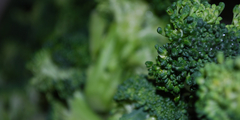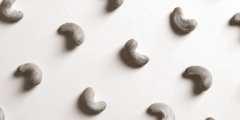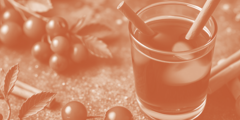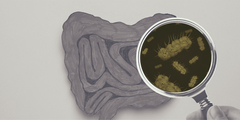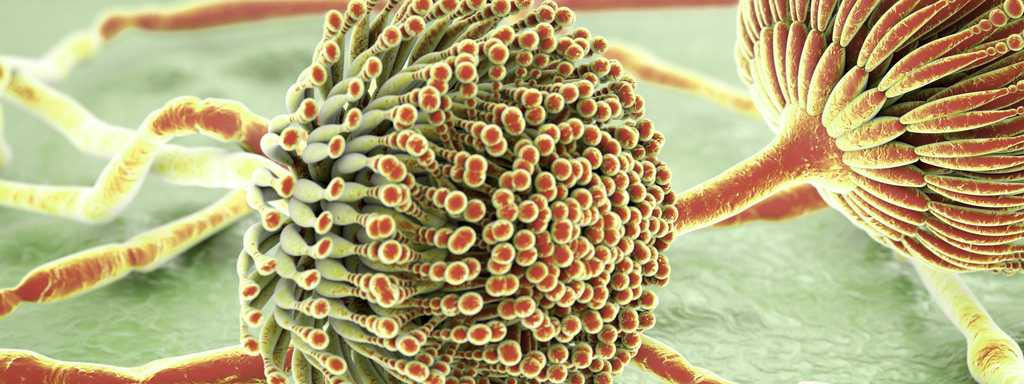
Aflatoxines zijn mycotoxines (gifstoffen uit schimmels) die worden geproduceerd door aspergillus-schimmels (A. flavus, A. parasiticus, A. nomius). Ze kunnen worden aangetroffen in (beschimmelde) granen (maïs, sorghum, tarwe), rijst, noten (pinda’s, paranoten, amandelen, cashewnoten, pistachenoten), zaden, peulvruchten (waaronder sojabonen), gedroogd fruit, kruiden en specerijen. Aspergillusgroei vindt vooral plaats tijdens productie en opslag in een warme en vochtige omgeving. Via dierenvoer kunnen aflatoxines in melk, kaas, eieren, kweekvis en vlees belanden.1
Beste bezoeker, u heeft geen toegang.
Enkel (web)abonnees hebben toegang tot tijdschriftartikelen. Het webabonnement is nog in de maak.
U kunt zich wel alvast (gratis) registreren en tal van andere webartikelen raadplegen!
Auteur
Verschenen in
Referenties
Umesha S et al. Aflatoxins and food pathogens: impact of biologically active aflatoxins and their control strategies. J Sci Food Agric. 2017;97(6):1698-1707.
van Dongen A. Controle faalt op veiligheid voedsel van buiten Europa. Algemeen Dagblad, 14 september 2017. https://www.ad.nl/economie/controle-faalt-op-veiligheid-voedsel-van-buit...
Tosun H et al. Determination of aflatoxin B1 levels in organic spices and herbs. Scientific World Journal. 2013;2013:874093.
Staatssecretaris van EZ (2013). Voedselveiligheid. Kamerstuk 26991 nr. 342. 13 maart 2013. Den Haag.
Unnevehr L et al. Aflatoxins: finding solutions for improved food safety. International Food Policy Research Institute (IFPRI). Washington, 2013. http://dx.doi.org/10.2499/9780896296763
Ahlberg SH et al. Potential of lactic acid bacteria in aflatoxin risk mitigation. Int J Food Microbiol. 2015;207:87-102.
Wild CP et al. A model of interaction: Aflatoxins and hepatitis viruses in liver cancer aetiology and prevention. Cancer Lett. 2009;286(1):22-28.
Jubert C et al. Effects of chlorophyll and chlorophyllin on low-dose aflatoxin B(1) pharmacokinetics in human volunteers. Cancer Prev Res (Phila) 2009;2(12):1015–22.
Abdel-Wahhab MA et al. Antioxidants and radical scavenging properties of vegetable extracts in rats fed aflatoxin-contaminated diet. J Agric Food Chem. 2003;51(8):2409-14.
Yilmaz S et al. The effect on oxidative stress of aflatoxin and protective effect of lycopene on aflatoxin damage. In: Aflatoxin-control, analysis, detection and health risks. InTechOpen, 2017. https://www.intechopen.com/books/aflatoxin-control-analysis-detection-an...
Tang L et al. Modulation of aflatoxin biomarkers in human blood and urine by green tea polyphenols intervention. Carcinogenesis. 2008;29(2):411-7.
Probst C et al. Outbreak of an acute aflatoxicosis in Kenya in 2004: identification of the causal agent. Appl Environ Microbiol. 2007;73(8):2762-2764.
Phillips TD et al. Reducing human exposure to aflatoxin through the use of clay: a review. Food Addit Contam Part A Chem Anal Control Expo Risk Assess. 2008;25(2):134-45.
Mitchell NJ et al. Reduction in the urinary aflatoxin M1 biomarker as an early indicator of the efficacy of dietary interventions to reduce exposure to aflatoxins. Biomarkers. 2013;18(5):391–8.
Mitchell NJ et al. Short-term safety and efficacy of calcium montmorillonite clay (UPSN) in children. Am J Trop Med Hyg. 2014;91(4):777–85.
Simonich MT et al. Natural chlorophyll inhibits aflatoxin B1-induced multi-organ carcinogenesis in the rat. Carcinogenesis. 2007;28(6):1294-1302.
Dogi C et al. Aflatoxins and Saccharomyces cerevisiae: yeast modulates the intestinal effect of aflatoxins, while aflatoxin B1 influences yeast ultrastructure. World Mycotoxin J. 2017:10(2):171-181.
Hernandez-Mendoza A et al. Screening of Lactobacillus casei strains for their ability to bind aflatoxin B1. Food Chem Toxicol. 2009;47(6):1064-8.
Huang L et al. Reduction of aflatoxin B1 toxicity by Lactobacillus plantarum C88: a potential probiotic strain isolated from Chinese traditional fermented food "tofu". PLoS One. 2017;12(1):e0170109.
Nada S et al. Saccharomyces cerevisiae and probiotic bacteria potentially inhibit aflatoxins production in vitro and in vivo studies. Internet J Toxicol. 2010;8(1).
Kabak B et al. Biological strategies to counteract the effects of mycotoxins. J Food Prot. 2009;72(9):2006-16.
Chen L et al. Therapeutic properties of green tea against environmental insults. J Nutr Biochem. 2017;40:1-13.
Yang CS et al. Molecular targets for the cancer preventive activity of tea polyphenols. Mol Carcinog. 2006;45(6):431-5.
Qin G et al. Inhibition of aflatoxin B1-induced initiation of hepatocarcinogenesis in the rat by green tea. Cancer Lett. 1997;112(2):149–54.
Luo H et al. Phase IIa chemoprevention trial of green tea polyphenols in high-risk individuals of liver cancer: modulation of urinary excretion of green tea polyphenols and 8-hydroxydeoxyguanosine. Carcinogenesis. 2006;27:262-268.
Jha A et al. Protective effect of black tea infusion on aflatoxin-induced hepatotoxicity in mice. J Clin Exp Hepatol. 2013;3:29-36.
Alm-Eldeen AA et al. Synergistic effect of black tea and curcumin in improving the hepatotoxicity induced by aflatoxin B1 in rats. Toxicol Ind Health. 2015;31(12):1269-80.
Poapolathep S et al. The effects of curcumin on aflatoxin B1-induced toxicity in rats. Biocontrol Sci. 2015;20(3):171-7.
El-Bahr SM. Effect of curcumin on hepatic antioxidant enzymes activities and gene expressions in rats intoxicated with aflatoxin B1. Phytother Res. 2015;29(1):134-40.
Zhang NY et al. Curcumin prevents aflatoxin B1 hepatoxicity by inhibition of cytochrome P450 isozymes in chick liver. Toxins. 2016;8:327.
Iqbal M et al. Dietary supplementation of curcumin enhances antioxidant and phase II metabolizing enzymes in ddY male mice: possible role in protection against chemical carcinogenesis and toxicity. Pharmacol Toxicol. 2003n;92(1):33-8.
El-Mahalaway AM. Protective effect of curcumin against experimentally induced aflatoxicosis on the renal cortex of adult male albino rats: a histological and immunohisochemical study. Int J Clin Exp Pathol 2015;8(6):6019-30.
Zhang Y et al. High cellular accumulation of sulphoraphane, a dietary anticarcinogen, is followed by rapid transporter-mediated export as a glutathione conjugate. Biochem J. 2002;364(Pt 1):301-7.
Kensler TW et al. Effects of glucosinolate-rich broccoli sprouts on urinary levels of aflatoxin-DNA adducts and phenanthrene tetraols in a randomized clinical trial in He Zuo township, Qidong, People’s Republic of China. Cancer Epidemiol Biomarkers Prev. 2005;14(11 Pt 1):2605-13.
Obuseh FA et al. Aflatoxin B1 albumin adducts in plasma and aflatoxin M1 in urine are associated with plasma concentrations of vitamins A and E. Int J Vitam Nutr Res. 2010;80(6):355-368.
Verma RJ et al. Vitamin E ameliorates aflatoxin-induced biochemical changes in the testis of mice. Asian J Androl. 2001;3(4):305-9.
Verma RJ et al. Vitamin E ameliorates aflatoxin-induced alterations in the epididymis of mice. Acta Pol Pharm. 2008;65(3):331-7.
Galvano F et al. Dietary strategies to counteract the effects of mycotoxins: a review. J Food Prot. 2001;64(1):120-31.
Sasaki K et al. Thyme (Thymus vulgaris L.) leaves and its constituents increase the activities of xenobiotic-metabolizing enzymes in mouse liver. J Med Food. 2005;8(2):184-9.
Bergès R et al. Comparison of the chemopreventive efficacies of garlic powders with different alliin contents against aflatoxin B1 carcinogenicity in rats. Carcinogenesis. 2004;25(10):1953-9.
Tadi PP et al. Binding of aflatoxin B1 to DNA inhibited by ajoene and diallyl sulfide. Anticancer Res. 1991;11(6):2037-41.
Abdel-Hamid AA et al. Vitamin E supplementation ameliorates aflatoxin B1-induced nephrotoxicity in rats. Acta Histochem. 2015;117(8):767-79.
Dinkova-Kostova AT et al. Induction of the phase 2 response in mouse and human skin by sulforaphane-containing broccoli sprout extracts. Cancer Epidemiol Biomarkers Prev. 2007;16(4):847–51.
Williams JH et al. Human aflatoxicosis in developing countries: a review of toxicology, exposure, potential health consequences, and interventions. Am J Clin Nutr. 2004;80:1106-22.



